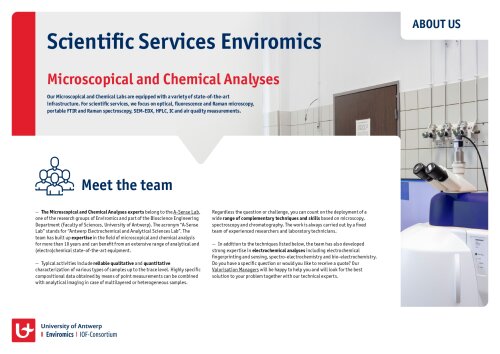Scientific Services Enviromics
Our Microscopical and Chemical Labs are equipped with a variety of state-of-the-art infrastructure. For scientific services, we focus on optical, fluorescence and Raman microscopy,portable FTIR and Raman spectroscopy, SEM-EDX, HPLC, IC and air quality measurements.

Find a full overview of our services here.
- Optical and fluorescence microscopy: Optical microscopy generates magnified images of small objects, allowing the observation of the samples’ morphology in detail with a resolution of 0.4 μm. Optical microscopy can be used with visible light, providing images of the samples and their real colors. Furthermore, optical microscopy can be coupled to a monochromatic light source that illuminates the sample in the range of 365 to 770 nm. This provides information on the samples’ heterogeneity at the microscopic level and is referred to
as fluorescence microscopy. - Raman microscopy: Raman microscopy is a powerful molecular characterization technique allowing to obtain key information on the chemical composition of unknown samples. A monochromatic laser source is focused down to less than a micron and illuminates the material of interest. The interaction of the material with the laser light causes so-called Raman scattered light which contains information regarding the chemical bounds present.
- Portable Fourier transform infrared and Raman spectroscopies: Fourier transform infrared (FTIR) and Raman spectroscopies are powerful molecular characterization techniques allowing to obtain key information on the chemical composition of unknown samples. Both techniques exploit the interaction of a light beam (infrared light for FTIR and a visible laser for Raman) with the sample to understand its molecular and structural properties. The different light sources and working principles of these techniques make it possible to obtain different and complementary information, with a strong synergic effect when used together.
- SEM-EDX: With scanning electron microscopy (SEM), an extremely fine electron beam is rapidly moved back and forth across the sample. The interaction of the electron beam with the sample releases various signals. These signals are detected and used by software to form a
pixel-by-pixel image of the sample. In addition to the typical detection of electrons, it is also possible to detect characteristic X-rays using an energy dispersive X-ray (EDX) detector. - High-performance liquid chromatography: High Performance Liquid Chromatography (HPLC) is a process of separating components in a liquid mixture. A liquid sample is injected into a stream of solvent (mobile phase) flowing through a column packed with a separation medium (stationary phase). By using different stationary phases (C18-, biphenyl, HILIC) and mobile phases, HPLC can separate and quantify a wide variety of analytes in a diversity of matrices.
- Ion chromatography: Ion chromatography (IC) is a process of separating ions in a liquid mixture. A liquid sample is injected into a mobile aqueous stream (mobile phase) flowing through an ion exchanger (stationary phase). By using different ion exchangers, anions or cations can be separated and analyzed.
- Air quality: Air quality is important both indoors and outdoors. Poor or suboptimal air quality may limit people’s ability to be physically active and is caused by e.g. poorly insulated windows, non-regular maintenance of HVAC, living near busy crossroads, … . Measuring certain air quality parameters gives a general idea of the air quality where it matters.